|
Frayser’s Farm (Glendale)
Other Names: Glendale, Frayser's Farm, Frazier's Farm, Nelson’s Farm, Charles City Crossroads, White Oak Swamp, New Market Road, Riddell's Shop
Location: Henrico County
Campaign: Peninsula Campaign (March-July 1862)
Date(s): June 30,
1862
Principal Commanders: Maj. Gen. George B. McClellan [US]; Gen. Robert E. Lee [CS]
Forces Engaged: Armies
Estimated Casualties: 7,500 total
Result(s): Inconclusive
(Union withdrawal continued.)
| Battle of Frayser's Farm / Glendale Map |
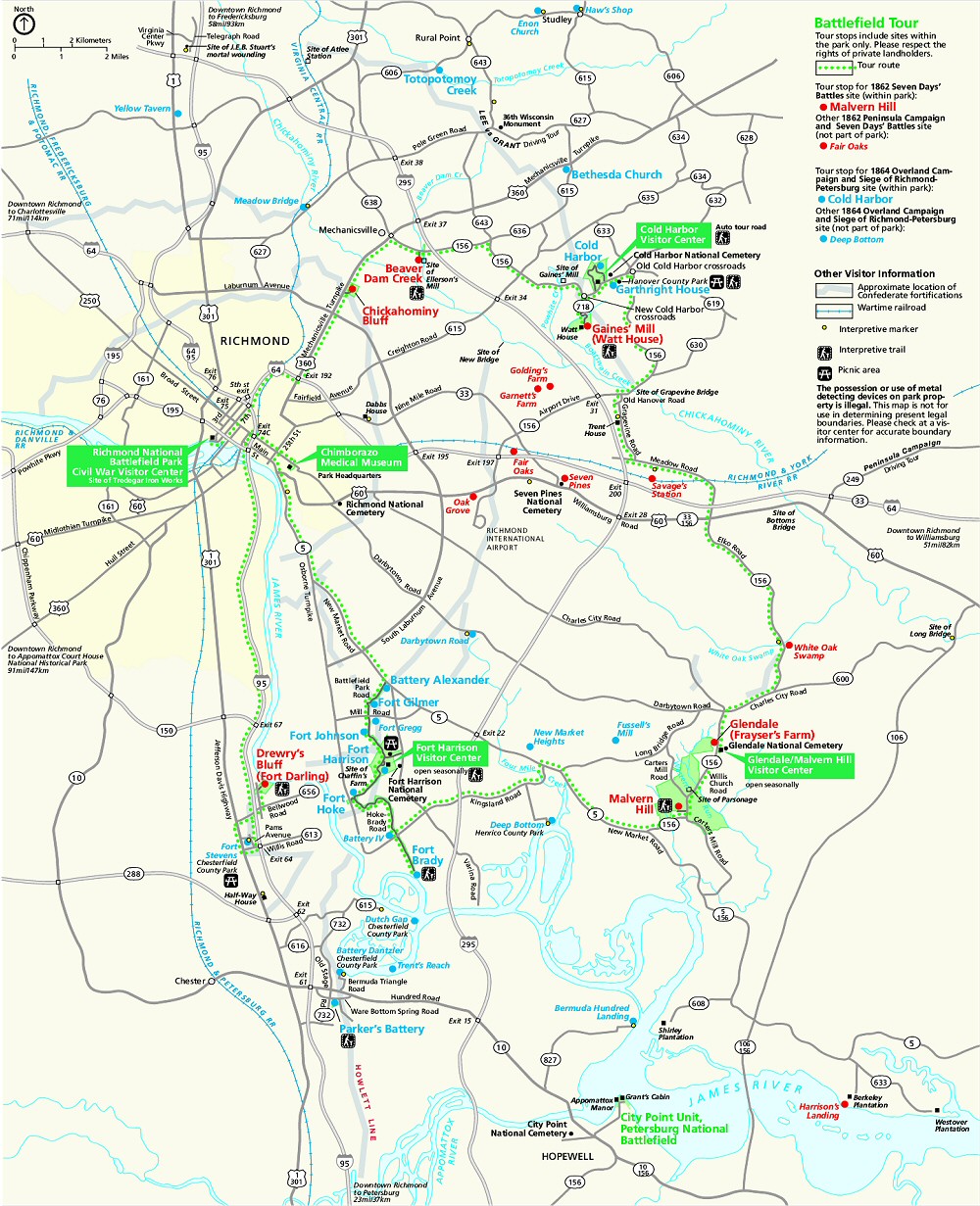
|
| Battle of Frayser's Farm |
Summary: The Battle of Frayser's Farm was the fifth
of the Seven Days Battles and was fought on June 30, 1862, when Huger’s, Longstreet’s,
and A. P. Hill’s divisions converged on the retreating Union army in the vicinity of Glendale or Frayser’s Farm.
Longstreet’s and Hill’s attacks penetrated the Union defense
near Willis Church, routing McCall’s division. McCall was captured. Union counterattacks by Hooker’s and
Kearny’s divisions sealed the break and saved their line of retreat along the Willis Church Road. Huger’s advance
was stopped on the Charles City Road. "Stonewall" Jackson's divisions were delayed by Franklin at White Oak Swamp. Confederate Maj.
Gen. T. H. Holmes made a feeble attempt to turn the Union left flank at Turkey Bridge but was driven back by Federal gunboats
in the James River. Union generals Meade and Sumner and Confederate generals Anderson, Pender, and Featherston were wounded.
This was Lee’s best chance to cut off the Union army from the James River. That night, McClellan established a strong
position on Malvern Hill.
| Battle of Frayser's Farm Map |
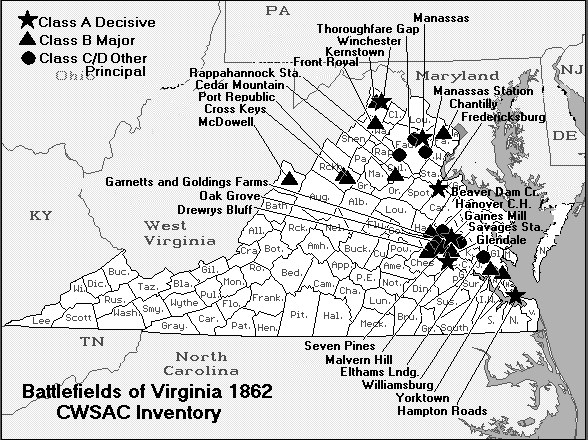
|
| Civil War Battle of Frayser's Farm - aka Battle of Glendale Map |
| Seven Days Battles Map |
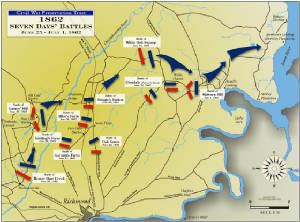
|
| Seven Days Battles Map |
| The Peninsula Campaign Battles Map |
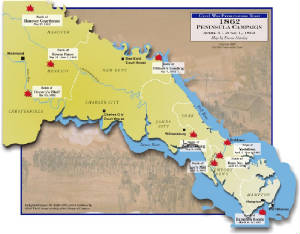
|
| The Peninsula Campaign Battles |
Seven Days Battles: With
a Federal army of more than 100,000 well-supplied soldiers poised on its eastern flank, the citizens of Richmond, Virginia,
warily awaited news from the tenuous lines along the swampy Chickahominy River. Would the Union Army, after victories at Fort
Henry and Donelson, take Richmond as its ultimate prize? Would the brief tenure of the Confederacy come to a quick and inglorious
end in the summer of 1862?
In what would prove to be one of the more savage and remarkable campaigns of the American Civil
War, the Army of Northern Virginia under the leadership of a new commander named Robert E. Lee (replacing General Joseph Johnston
who had been wounded during the Battle of Seven Pines) would take to the offensive against George B. McClellan and his mighty
Army of the Potomac.
Over the next week, during the Seven Days Battles (the last week of battles within the "Peninsula Campaign"),
the Army of Northern Virginia would deliver blow after blow at Beaver Dam Creek, Gaines’s Mill, Savage Station, Glendale,
and Malvern Hill. Gone were the days of torpor and defensive maneuver. Lee would usher in a new era of offensive combat that
would not only completely unnerve George McClellan, but would force the evacuation of the Union army from the region. Lee's
victory in the Seven Days would mean that the savage fighting of the Civil War would continue for 3 more hard years.
The second phase of the Peninsula Campaign, known as the Seven Days Battles, included the Battle of Frayser's Farm. The
Seven Days Battles (June 25–July 1, 1862) took a negative turn for the Federals when Lee assumed command of
the Army of Northern Virginia and launched fierce counterattacks just east of Richmond. Although they are formally considered part of
the Peninsula Campaign, the final battles of June 25 to July 1, with Lee in command and on the offensive against McClellan,
are popularly known as the Seven Days Battles.
| Frayser's Farm Civil War Battle |
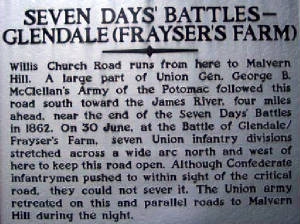
|
| Frayser's Farm Historical Marker |
| General McClellan and General Lee |
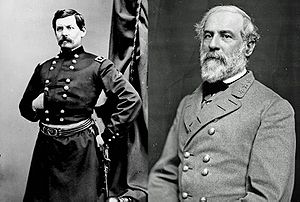
|
| Opposing Commanding Generals |
The Battle of Frayser's Farm was tactically inconclusive, although
Robert E. Lee failed to achieve his objective of preventing the Federal escape and crippling McClellan's army, if not destroying
it. James Longstreet's performance had been poor, sending in brigade after brigade in a piecemeal fashion, rather than striking
with concentrated force in the manner for which he would be known later in the war. He also was not supported by Huger and
Jackson,
as Lee had planned. Fortunately for Lee, his losses were not significantly higher at Frayser's Farm, but McClellan's army withdrew in the night
and established an even stronger position at nearby Malvern Hill, where the Confederates would suffer a lopsided defeat
while conducting several poorly executed and ill-fated frontal assaults
against well-entrenched Union artillery positions.
Union
casualties were 3,797 (297 killed, 1,696 wounded, and 1,804 missing or captured). Confederate casualties were comparable in
total—3,673 (638 killed, 2,814 wounded, and 221 missing)—but more than 40% higher in killed and wounded. Longstreet
lost more than a quarter of his division. Union generals Meade and Edwin V. Sumner and Confederate generals Joseph
R. Anderson, Dorsey Pender, and Winfield S. Featherston were wounded.
| "Stonewall" Jackson Advances |
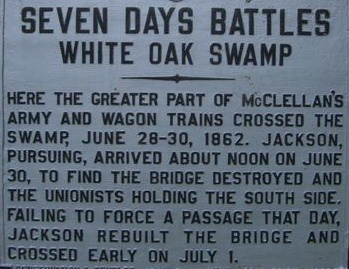
|
| "Stonewall" Jackson Engages at Frayer's Farm |
| Battle of Frayser's Farm |
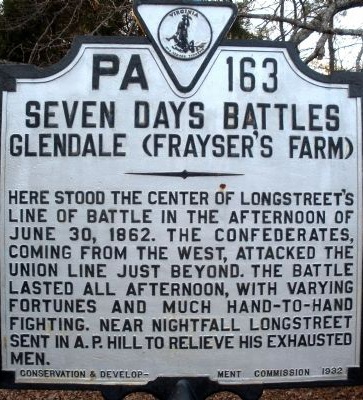
|
| Frayser's Farm and Seven Days Battles |
McClellan and Lee: The Peninsula Campaign (aka Peninsular Campaign) during the American Civil War was a major Union operation
launched in southeastern Virginia from March through July 1862, and it was the first large-scale offensive in the Eastern
Theater. The operation, commanded by Maj. Gen. George B. McClellan, was an amphibious turning movement intended to capture
the Confederate capital of Richmond by circumventing the Confederate States Army in Northern Virginia. McClellan was initially
successful against the equally cautious General Joseph E. Johnston, but the emergence of the aggressive General Robert E.
Lee, who assumed command immediately following Seven Pines or Fair Oaks, turned the subsequent Seven Days Battles into a humiliating Union defeat.
Background: The
Seven Days Battles began with a Union attack in the minor Battle of Oak Grove on June 25, 1862, but McClellan quickly lost
the initiative as Lee began a series of attacks at Mechanicsville (or Beaver Dam Creek) on June 26, Gaines' Mill on June 27,
the minor actions at Garnett's and Golding's Farm on June 27 and June 28, and the attack on the Union rear guard at Savage's
Station on June 29. McClellan's Army of the Potomac continued its retreat toward the safety of Harrison's Landing on the James River.
After Gaines' Mill, McClellan
left his army with no clear instructions on routes of withdrawal and without naming a second-in-command. The bulk of the V
Corps (less McCall), under Brig. Gen. Fitz John Porter, moved to occupy Malvern Hill, while the remaining four corps of the
Army of the Potomac were essentially operating independently in their fighting withdrawal. Most elements of the army had been
able to cross White Oak Swamp Creek by noon on June 30. About one third of the army had reached the James River, but the remainder
was still marching between White Oak Swamp and Glendale. (Glendale
was the name of a tiny community at the intersection of the Charles City Road
and the Quaker Road, or Willis Church Road, which led over Malvern Hill to the James River.)
After inspecting the line of march that morning, McClellan rode south and boarded the ironclad USS Galena on the
James.
| Battle of Frayser's Farm |
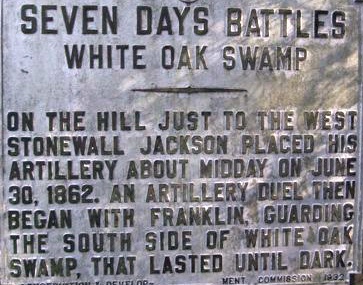
|
| White Oak Swamp and Frayser's Farm |
Lee ordered his Army of Northern
Virginia to converge on the retreating Union forces, bottlenecked on the inadequate road network. The Army of the Potomac, lacking overall
command coherence, presented a discontinuous, ragged defensive line. Stonewall Jackson was ordered to press the Union rear
guard at the White Oak Swamp crossing while the largest part of Lee's army, some 45,000 men, would attack the Army of the
Potomac in mid-retreat at Glendale, about 2 miles southwest, splitting it in two. Huger's division would strike first after
a three-mile march on the Charles City Road, supported by Longstreet and A.P. Hill, whose divisions were about 7 miles to
the west, in a mass attack. Holmes was ordered to cannonade retreating Federals near Malvern Hill.
The Battles: On
the evening of June 30, McClellan, who had witnessed none of the fighting, wired the War Department: "My Army has behaved
superbly and have done all that men could do. If none of us escape we shall at least have done honor to the country. I shall
do my best to save the Army." He later requested 50,000 reinforcements (which the War Department had no chance of providing).
"With them, I will retrieve our fortunes."
| Battle of Glendale Map |
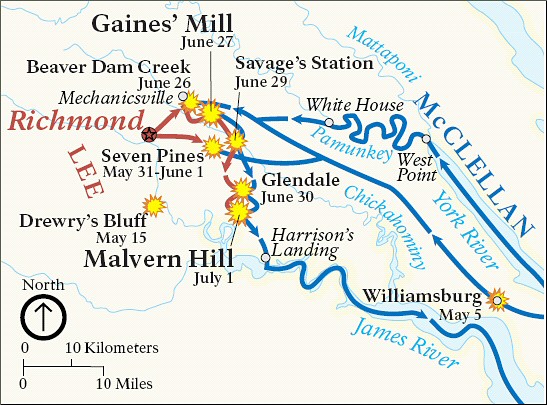
|
| Seven Days Battles of the Peninsula Campaign |
| Battle of Frayser's Farm Map |
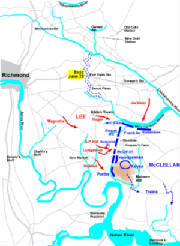
|
| Civil War Seven Days Battles |
| Battle of White Oak Swamp |
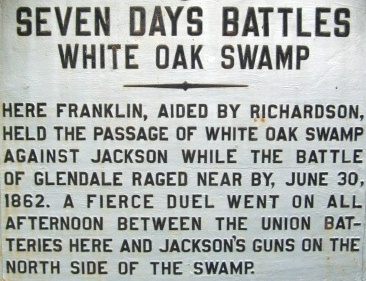
|
| White Oak Swamp Marker |
Battle of White
Oak Swamp: "Stonewall" Jackson's men marched south on the White
Oak Road with their artillery chief, Colonel Stapleton Crutchfield, at the head of the column.
They marched slowly because they were accompanied by thousands of wounded Union prisoners and many of the stores that they
obtained at Savage's Station. They found that the single bridge over the swamp had been burned two hours earlier.
Right) Battlefield Map of
Union and Confederate Armies maneuvering at the Battle of Glendale (Frayser's Farm).
Jackson arrived at noon
and approved Crutchfield's gun emplacement that was designed to fire diagonally from a ridge across the swamp against the
Union batteries and infantry positions that they saw about 300 yards away. At 2 p.m. on June 30, seven Confederate batteries
of 31 guns opened fire, catching the Union troops by surprise and disabling several of their cannons.
After ordering his engineers
to begin rebuilding the bridge, Jackson directed Col. Thomas
T. Munford's 2nd Virginia Cavalry to cross the swamp and capture some of the Union guns abandoned during the bombardment.
As the men and horses waded through water that was belly deep and fouled with debris, Jackson
and Maj. Gen. D.H. Hill crossed the river to perform a personal reconnaissance. A Union artillery shell exploded only a few
feet away from the generals mounted on horseback, although neither was injured. Jackson
saw that Union artillery and infantry was reinforcing the position, and that Federal sharpshooters would play havoc with his
engineers on the bridge. He realized that this was not a place that he could make an opposed crossing.
Munford reported that he found
ford a quarter of a mile downstream that would be suitable for the infantry to cross. Brig. Gen. Wade Hampton found a closer
point at which a simple bridge could be built for infantry. Jackson
ordered him to build the bridge, but took no specific action to cross the swamp, having decided that it was infeasible to
attack if he could not cross his artillery. While the artillery duel across the swamp escalated to over 40 guns, and while
the battle at Glendale raged less than 3 miles away, Jackson
sat beneath a large oak tree and fell asleep for over an hour.
| Battle of White Oak Swamp |
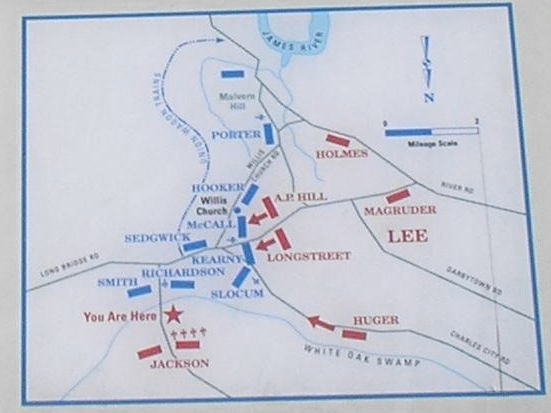
|
| Battle of White Oak Swamp, VA |
| Battle of Glendale |
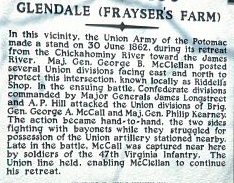
|
| Battle of Frayser's Farm (or Glendale) |
| Battle of Frayser's Farm |
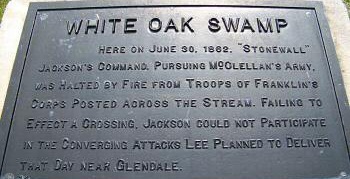
|
| Jackson Delayed at White Oak Swamp |
Battle of Frayser's Farm: As with most of the Seven Days Battles, Lee's plan was poorly executed. Huger was slowed by
felled trees obstructing the Charles City Road, a result of the efforts of pioneers from Brig.
Gen. Henry W. Slocum's division. Huger had his men spend hours chopping a new road through the thick woods. He failed to take
any alternative route, and, fearing a counterattack, failed to participate in the battle.
By 4 p.m., Lee ordered Maj.
Gen. John B. Magruder to join Holmes on the River Road and attack Malvern Hill then ordered him to assist Longstreet, so his
division spent the day countermarching.
Stonewall Jackson moved slowly and spent the entire day north of the creek, making only feeble efforts to
cross and attack Franklin's VI Corps in the Battle of White
Oak Swamp, attempting to force back the enemy so that a destroyed bridge could be rebuilt, although adequate fords were nearby,
by a fruitless artillery duel. (Despite his stunning victories in the recent Valley Campaign, or perhaps due to the fatigue
of that campaign, Jackson's contributions to the Seven Days
were marred by slow execution and poor judgment throughout.) His presence did draw two of Brig. Gen. John Sedgwick's three
brigades, which had been defending the Charles City crossroads, north as reinforcements. McCall's division had stopped at Charles City
Crossroads on its march to rejoin Porter. The gap in the line left by Sedgwick was noticed and plugged by his three brigades.
Holmes' troops made no progress against Porter at Turkey Bridge
and Malvern Hill and were repulsed by artillery fire and by the Federal gunboats Galena and
Aroostook on the James.
| Civil War Battle of Glendale Map |
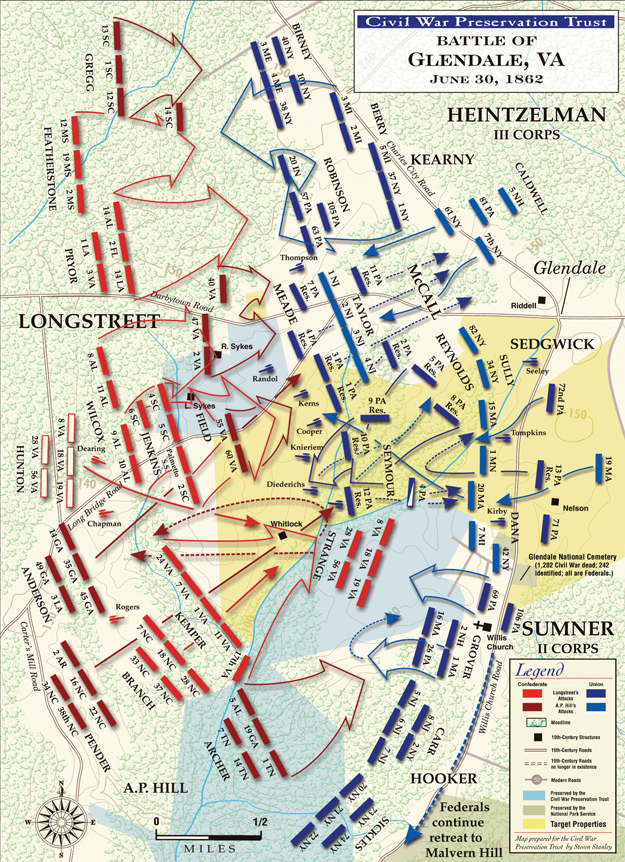
|
| Battle of Frayser's Farm |
(Right) Plan of the battle of Glendale and White Oak Swamp, Virginia, also known as Frazier's Farm and Charles
City Crossroads, fought June 30th, 1862, 10 a.m. to 5 p.m. Courtesy Library of Congress.
| Battle of Glendale and White Oak Swamp |
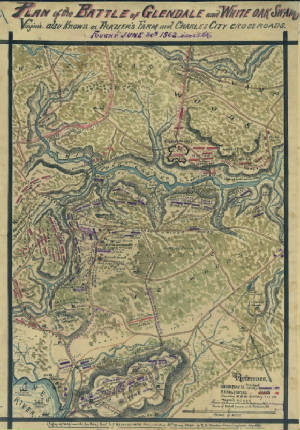
|
| Battle of Glendale and White Oak Swamp |
| Battle of Glendale Battlefield Map |
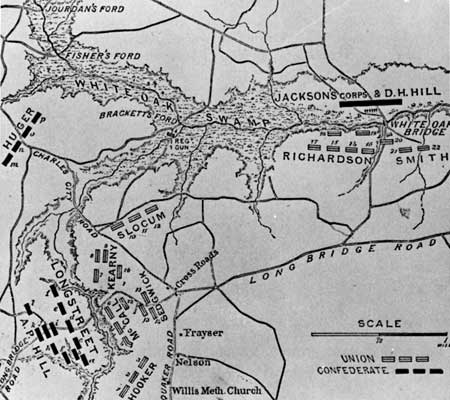
|
| Frayser's Battlefield |
| Historic Battlefield Map of Glendale |
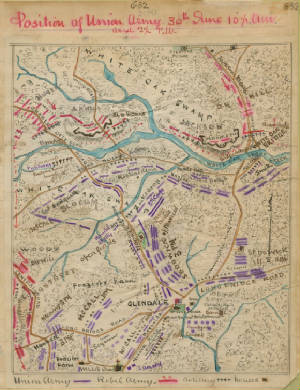
|
| Historic Frayser's Farm Battlefield Map |
At
2 p.m., as they waited for sounds of Huger's expected attack, Lee, Longstreet, and visiting Confederate President Jefferson
Davis were conferring on horseback when they came under heavy artillery fire, wounding two men and killing three horses. A.P.
Hill, the commander in that sector, ordered the president and senior generals to the rear. Longstreet attempted to silence
the six batteries of Federal guns firing in his direction, but long-range artillery fire proved to be inadequate. He ordered
Col. Micah Jenkins to charge the batteries, which brought on a general fight around 4 p.m.
Although belated and not
initiated as planned, the assaults by the divisions of A.P. Hill and Longstreet, under Longstreet's overall command, turned
out to be the only ones to follow Lee's order to attack the main Union concentration. Longstreet's 20,000 men were not reinforced
by other Confederate divisions of Huger and Jackson, despite their concentration within a three-mile
radius. They assaulted the disjointed Union line of 40,000 men, arranged in a two-mile arc north and south of the Glendale
intersection, but the brunt of the fighting was centered on the position held by the Pennsylvania Reserves division of the
V Corps, 6,000 men under Brig. Gen. George A. McCall, just west of the Nelson Farm owned by Nelson, north of Willis Church.
(The farm was owned by R.H. Nelson, but its former owner was named Frayser and many of the locals referred to it as Frayser's,
or Frazier's, Farm.) McCall's division included the brigades of Brig. Gen. George G. Meade on the right and Brig. Gen. Truman
Seymour on the left, with the brigade of Brig. Gen. John F. Reynolds (led by Col. Seneca G. Simmons since Reynolds's capture
at Boatswain's Swamp after Gaines' Mill) in reserve.
(Right) Historic
Battle of Glendale Map reflecting Battlefield Positions of Union Army 30th June 10 1/2 a.m. and 2 1/2
p.m. Courtesy Library of Congress.
Three Confederate brigades
were sent forward in the assault, from north to south: Brig. Gen. Cadmus M. Wilcox, Col. Micah Jenkins (Anderson's Brigade), and Brig. Gen. James L. Kemper. Longstreet ordered them forward in a
piecemeal fashion, over several hours. Kemper's Virginians charged through the thick woods first and emerged in front of five
batteries of McCall's artillery. In their first combat experience, the brigade conducted a disorderly but enthusiastic assault,
which carried them through the guns and broke through McCall's main line with Jenkins's support, followed up a few hours later
by Wilcox's Alabamians. The Confederate brigades met stiff resistance from Meade and Seymour in sometimes hand-to-hand combat.
Meade was wounded in the fighting, two of his artillery batteries captured (Lt. Alanson Randol's and Capt. James Cooper's),
but one was retaken. McCall was captured when he mistakenly rode into the Confederate picket line, looking for positions to
place his rallied men.
On McCall's northern flank, the
division of Brig. Gen. Philip Kearny held against repeated Confederate attacks with reinforcements of Caldwell's brigade and two brigades from Slocum's division. On the southern flank, Brig.
Gen. Joseph Hooker's division repelled and once pursued minor attacks. Sedgwick's division, whose brigades had returned from
near White Oak Swamp, came up to fill a gap after a brutal counterattack. Heavy fighting continued
until about 8:30 p.m. Longstreet committed virtually every brigade in the divisions under his command, while on the Union
side they had been fed in individually to plug holes in the line as they occurred.
| Battle of White Oak Swamp & Stonewall Jackson |
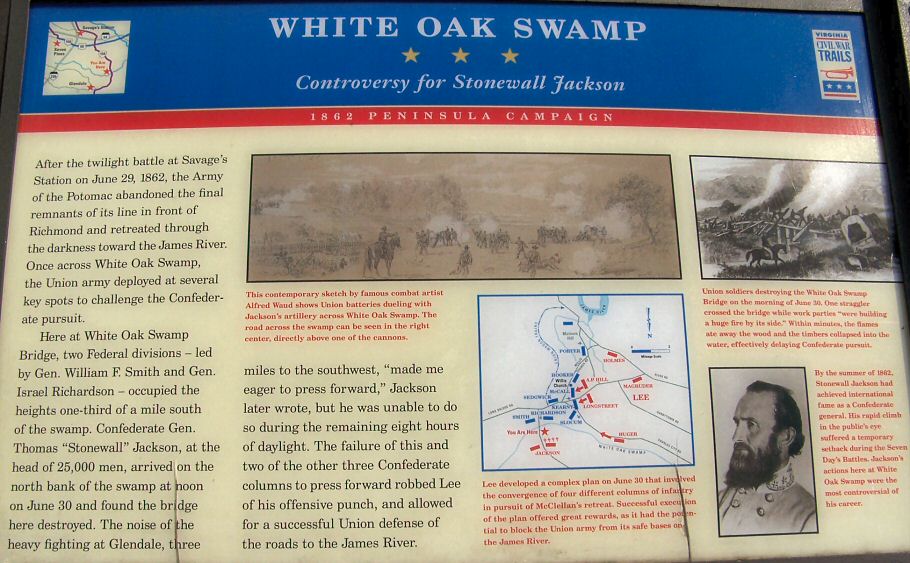
|
| The Fight at White Oak Swamp |
| Civil War Battle of Glendale Map |
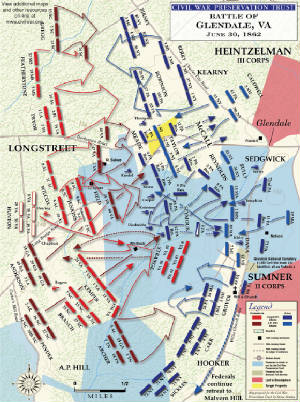
|
| Civil War Battle of Glendale Map |
| Battle of Frayser's Farm |
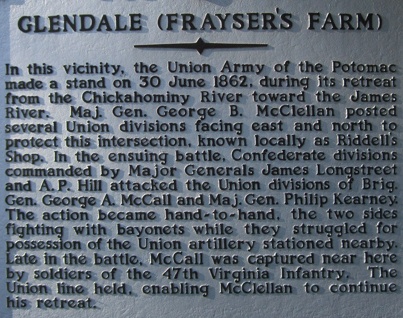
|
| Battle of Frayser's Farm |
(Right) Glendale Battlefield Map defining portions
of said battlefield forever lost to commercial development.
Aftermath:
McClellan has received significant criticism from historians about his detachment from the battle, sailing on the Galena out
of touch while his men fought. Ethan Rafuse wrote that after McClellan supervised the deployment of three corps near the Glendale
crossroads, what he did next "almost defies belief. ... Even though his men were at the time engaged in a fierce battle near
Glendale ... he spent the afternoon on board the Galena, dining with [Captain] Rodgers and traveling briefly up river to watch
the gunboat shelling of a Confederate division that had been spotted marching east along the River road toward Malvern Hill."
Brian K. Burton wrote that, "more than on any other day, McClellan's judgment on the thirtieth is suspect. He had arranged
for signal communications between Malvern Hill and the river but that is a poor substitute. To leave units from five different
corps at a vital point with no overall commander is to court disaster." Stephen Sears wrote "when McClellan deserted his army
on the Glendale and Malvern Hill battlefields during the Seven Days, he was guilty of dereliction of duty."
Jackson's
inaction allowed some units to be detached from Franklin's corps in late afternoon to reinforce
the Union troops at Glendale. Jackson
did not inform Lee of his situation and Lee did not send anyone to find Jackson
until it was too late to make a difference. Although Jackson's wing of the Army and Franklin's corps comprised tens of thousands of men, the action at White
Oak Swamp included no infantry activity and was limited to primarily an artillery duel. The Confederates lost 3 artillerymen
killed and 12 wounded, but there is no exact record of the number of Union casualties; historian Brian K. Burton estimates
as many as 100 Union casualties, with the highest losses in the 5th New Hampshire,
which had 5 men killed and 9 wounded.
After dinner with his staff that
night, Jackson fell asleep again, with a biscuit clenched
between his teeth. Upon awakening he announced, "Now, gentlemen, let us at once to bed, and rise with the dawn, and see if
tomorrow we can do something." Two weeks later he offered an explanation for his unusually lethargic conduct at the battle:
"If General Lee had wanted me, he could have sent for me." Lee never criticized Jackson's performance in the battle.
| Battle of Glendale |
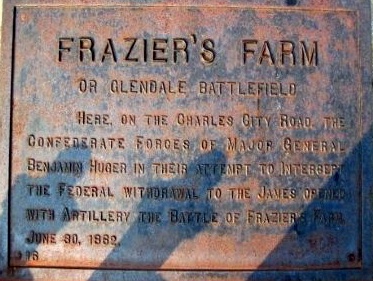
|
| Battle of Frayser's Farm |
After the battle, Lee wrote, "Could the other commands
have cooperated in this action, the result would have proved most disastrous to the enemy." Confederate Maj. Gen. D.H. Hill
was even more direct: "Had all our troops been at Frayser's Farm, there would have been no Malvern Hill." Confederate Brig.
Gen. Edward Porter Alexander wrote after the war that, "Never, before or after, did the fates put such a prize within our
reach. It is my individual belief that on two occasions in the four years, we were within reach of military successes so great
that we might have hoped to end the war with our independence. ... The first was at Bull Run [in] July 1861 ... This [second] chance of June 30, 1862 impresses me as the best
of all."
Edward Porter Alexander, the prominent
Confederate artillery commander and postwar historian, lamented about the great lost opportunity at Glendale
and White Oak Swamp: "When one thinks of the great chances in General Lee's grasp that one summer
afternoon, it is enough to make one cry ... to think that our Stonewall Jackson lost them." Lee would have only one more opportunity
to intercept McClellan's army before it reached the safety of the river and the end of the Seven Days, at the Battle of Malvern Hill on July 1.
| Glendale National Cemetery |
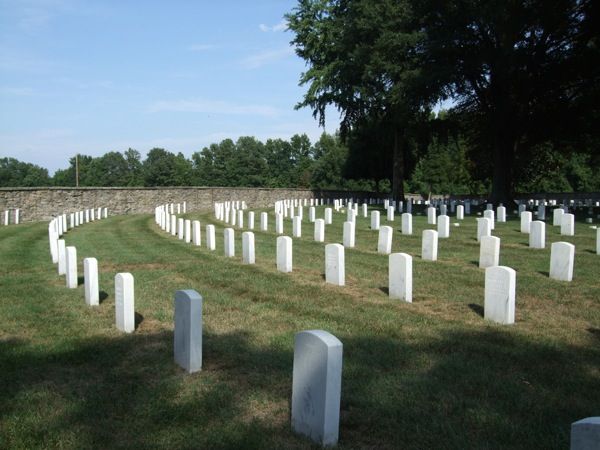
|
| (Virginia) |
| Glendale National Cemetery |
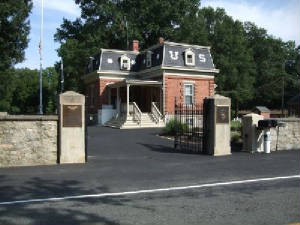
|
| (Virginia) |
Glendale National Cemetery: Glendale National Cemetery
is located in Henrico County, Va., approximately 13 miles
southeast of Richmond.
Glendale National Cemetery
was established May 7, 1866, on land purchased from a local resident, Lucy C. Nelson. The cemetery name is taken from the
farm located on this property, which served as a Union headquarters during the Civil War. Original interments were the remains
of Union soldiers recovered from Malvern Hill, Frayser’s Farm, Harrison’s Landing
and other areas in the vicinity of Richmond. An inspector’s report of July 26, 1871, notes a total of 1,189 interments,
including 236 known and 953 unknown gravesites. The cemetery is composed of a nearly square plan, with the graves laid out
in picturesque, concentric rows, and the cemetery was listed on the National Register of Historic Places in 1996.
It encompasses 2.1 acres, and
in 2005 had 2,064 interments. It is closed to new interments. The only interments that are being accepted are subsequent interments
for veterans or eligible family members in an existing gravesite. Periodically however, burial space may become available
due to a canceled reservation or when a disinterment has been completed. When either of these two scenarios occurs, the gravesite
is made available to another eligible veteran on a first-come, first-served basis. Since there is no way to know in advance
when a gravesite may become available, individuals may contact the cemetery at the time of need to inquire whether space is
available.
There are no monuments or memorials
located at Glendale National
Cemetery, but there are notable persons interred here, including Medal
of Honor recipient Corporal Michael Fleming Folland (Vietnam),
3rd Infantry, 199th Infantry Brigade. At Long Khanh, Providence Republic
of Vietnam, July 3, 1969 (Section H, Grave
846).
(Sources listed at bottom of page.)
Recommended Reading: The Richmond Campaign of 1862: The Peninsula
and the Seven Days, by Gary W. Gallagher (Military Campaigns of the Civil War). Description: The Richmond campaign of April-July 1862 ranks as one of the most important
military operations of the first years of the American Civil War. Key political, diplomatic, social, and military issues were
at stake as Robert E. Lee and George B. McClellan faced off on the peninsula between the York and James Rivers. The climactic
clash came on June 26-July 1 in what became known as the Seven Days battles, when Lee, newly appointed as commander of the
Confederate forces, aggressively attacked the Union army. Casualties for the entire campaign exceeded 50,000, more than 35,000
of whom fell during the Seven Days. Continued below…
This book offers nine essays in
which well-known Civil War historians explore questions regarding high command, strategy and tactics, the effects of the fighting
upon politics and society both North and South, and the ways in which emancipation figured in the campaign. The authors have
consulted previously untapped manuscript sources and reinterpreted more familiar evidence, sometimes focusing closely on the
fighting around Richmond and sometimes looking more broadly at the background and consequences of the campaign.
Recommended Reading: To The Gates of Richmond:
The Peninsula Campaign, by Stephen W. Sears. From Kirkus Reviews:
In George B. McClellan (1988) and his work editing the papers of the Union general, Sears established himself as the critical
but indispensable authority on flawed ``Little Mac.'' Now, in a stirring prequel to Landscape Turned Red (1983), his superb
account of the Battle of Antietam, the author reaffirms his mastery of historical narrative. In March 1862, the egotistical
but timorous McClellan was prodded by Lincoln into finally launching the first major offensive
by the Army of the Potomac. Instead of marching directly overland from Washington,
McClellan used Federal sea power to advance on Richmond by
way of the peninsula between the York and James Rivers. Continued below…
The ``Grand Campaign,'' however,
soon belied its creator's Napoleonic pretensions by becoming a three-and-a-half-month nightmare of feints and pitched battles,
ultimately engaging up to a combined quarter-million men on both sides and leaving one of every four men dead, wounded, or
missing. Using hundreds of eyewitness accounts, Sears demonstrates how the most creative use of military technology (ironclad
warships, 200-pounder rifled cannon, battlefield telegraph, and aerial reconnaissance) existed side by side with the most
appalling mismanagement (Stonewall Jackson's uncharacteristic lethargy; McClellan's mistaken belief that the numerically inferior
rebels possessed a two-to-one manpower advantage; out-of-sync attacks by both Confederate and Union generals). Above all,
though, Sears casts the campaign as a clash of wits and wills between McClellan--whom he accuses of losing ``the courage to
command''--and Robert E. Lee--who, upon succeeding the wounded Joseph E. Johnson as head of the Army of Northern Virginia,
seized the initiative, repulsed the assault in the series of ``Seven Days'' battles, and began his long journey into legend.
An authoritative, ironic, and stirring addition to Civil War annals. “…[No] serious study of the Peninsula Campaign
is possible without this book.” Americancivilwarhistory.org
Recommended Reading:
Extraordinary Circumstances: The Seven Days Battles (Library Binding).
Description: EXTRAORDINARY CIRCUMSTANCES tells the story of the Seven Days Battles, the first campaign in the Civil War in
which Robert E. Lee led the Army of Northern Virginia. One of the most decisive military campaigns in Western history, the
Seven Days were fought in the area southeast of the Confederate capitol of Richmond from June 25 to July 1, 1862--and began
a string of events leading to the Emancipation Proclamation and the shift toward total war.
Recommended
Reading:
The Richmond Campaign of 1862: The Peninsula and
the Seven Days (Military Campaigns of the Civil War). Description: The Richmond
campaign of April-July 1862 ranks as one of the most important military operations of the first years of the American Civil
War. Key political, diplomatic, social, and military issues were at stake as Robert E. Lee and George B. McClellan faced off
on the peninsula between the York and James Rivers. The climactic clash came on June 26-July 1 in what became known as the
Seven Days battles, when Lee, newly appointed as commander of the Confederate forces, aggressively attacked the Union army.
Casualties for the entire campaign exceeded 50,000, more than 35,000 of whom fell during the Seven Days. Continued below…
This
book offers nine essays in which well-known Civil War historians explore questions regarding high command, strategy and tactics,
the effects of the fighting upon politics and society both North and South, and the ways in which emancipation figured in
the campaign. The authors have consulted previously untapped manuscript sources and reinterpreted more familiar evidence,
sometimes focusing closely on the fighting around Richmond and sometimes looking more broadly at the background
and consequences of the campaign.
Recommended Reading: Seven Days Before Richmond: McClellan's Peninsula
Campaign of 1862 and its Aftermath (Hardcover). Description: Combining meticulous research with a unique
perspective, Seven Days Before Richmond examines the 1862 Peninsula Campaign of Union General George McClellan and the profound
effects it had on the lives of McClellan and Confederate General Robert E. Lee, as well as its lasting impact on the war itself.
Continued below…
Rudolph Schroeder's twenty-five
year military career and combat experience bring added depth to his analysis of the Peninsula Campaign, offering new insight
and revelation to the subject of Civil War battle history. Schroeder analyzes this crucial campaign from its genesis to its
lasting consequences on both sides. Featuring a detailed bibliography and a glossary of terms, this work contains the most
complete Order of Battle of the Peninsula Campaign ever compiled, and it also includes the identification of commanders down
to the regiment level. In addition, this groundbreaking volume includes several highly-detailed maps that trace the Peninsula
Campaign and recreate this pivotal moment in the Civil War. Impeccably detailed and masterfully told, Seven Days Before Richmond
is an essential addition to Civil War scholarship. Schroeder artfully enables us to glimpse the innermost thoughts and motivations
of the combatants and makes history truly come alive.
Recommended
Reading:
The Peninsula Campaign of 1862: A Military Analysis
(Hardcover). Description: The largest offensive of the Civil War, involving army, navy, and marine forces, the Peninsula Campaign
has inspired many history books. No previous work, however, analyzes Union general George B. McClellan's massive assault toward
Richmond in the context of current and enduring military doctrine.
The Peninsula Campaign of 1862: A Military Analysis fills this void. Background history is provided for continuity, but the
heart of this book is military analysis and the astonishing extent to which the personality traits of generals often overwhelm
even the best efforts of their armies. Continued below…
The
Peninsula Campaign lends itself to such a study. Lessons for those studying the art of war are many. On water, the first ironclads
forever changed naval warfare. At the strategic level, McClellan's inability to grasp Lincoln's grand objective becomes evident. At the operational
level, Robert E. Lee's difficulty in synchronizing his attacks deepens the mystique of how he achieved so much with so little.
At the tactical level, the Confederate use of terrain to trade space for time allows for a classic study in tactics. Moreover,
the campaign is full of lessons about the personal dimension of war. McClellan's overcaution, Lee's audacity, and Jackson's personal exhaustion all provide valuable insights for today's
commanders and for Civil War enthusiasts still debating this tremendous struggle. Historic photos and detailed battle maps
make this study an invaluable resource for those touring the many battlegrounds from Young's Mill and Yorktown through Fair Oaks to the final throes of the Seven Days' Battles. Kevin Dougherty, Hattiesburg,
Mississippi, is professor of military science at the University of Southern Mississippi. He is the
author of The Coastal War in North and South Carolina. J.
Michael Moore, Yorktown, Virginia, is the registrar of Lee Hall Mansion.
Sources: National
Park Service; Civil War Preservation Trust; Richmond National Battlefield (NPS); Alexander, Edward P., and Gallagher,
Gary W. (editor), Fighting for the Confederacy: The Personal Recollections of General Edward Porter Alexander, University
of North Carolina Press, 1989; Burton, Brian K., Extraordinary Circumstances: The Seven Days Battles, Indiana University Press,
2001; Eicher, David J., The Longest Night: A Military History of the Civil War, Simon & Schuster, 2001; Esposito, Vincent
J., West Point Atlas of American Wars, Frederick A. Praeger, 1959; Freeman, Douglas S., R. E. Lee, A Biography
(4 volumes), Scribners, 1934; Kennedy,
Frances H., ed., The Civil War Battlefield Guide, 2nd ed., Houghton Mifflin Co., 1998; Rafuse, Ethan S., McClellan's
War: The Failure of Moderation in the Struggle for the Union, Indiana University Press, 2005; Robertson,
James I., Jr., Stonewall Jackson: The Man, The Soldier, The Legend, MacMillan Publishing, 1997; Salmon, John S., The Official Virginia Civil War Battlefield Guide, Stackpole Books,
2001; Sears, Stephen W., Controversies & Commanders: Dispatches from the Army of the Potomac, Houghton Mifflin
Co., 1999; Sears, Stephen W., To the Gates of Richmond: The
Peninsula Campaign, Ticknor and Fields, 1992; U.S. War Department, The War of the Rebellion: a Compilation of the Official
Records of the Union and Confederate Armies, U.S. Government Printing Office, 1880–1901; Welcher, Frank J., The
Union Army, 1861–1865 Organization and Operations, Volume I: The Eastern Theater, Indiana
University Press, 1989; Wert, Jeffry D., The Sword of Lincoln: The Army of the Potomac,
Simon & Schuster, 2005.
|

